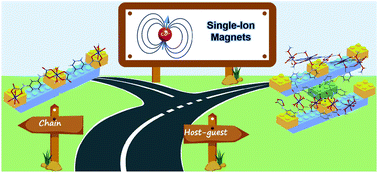Building-up host–guest helicate motifs and chains: a magneto-structural study of new field-induced cobalt-based single-ion magnets†
Abstract
In this work, we present the synthetic pathway, a refined structural description, complete solid-state characterization and the magnetic properties of four new cobalt(II) compounds of formulas [Co(H2O)6][Co2(H2mpba)3]·2H2O·0.5dmso (1), [Co(H2O)6][Co2(H2mpba)3]·3H2O·0.5dpss (2), [Co2(H2mpba)2(H2O)4]n·4nH2O (3), and [Co2(H2mpba)2(CH3OH)2(H2O)2]n·0.5nH2O·2ndpss (4) [dpss = 2,2′-dipyridyldisulfide and H4mpba = 1,3-phenylenebis(oxamic) acid], where 2 and 4 were obtained from [Co(dpss)Cl2] (Pre-I) as the source of cobalt(II). All four compounds are air-stable and were prepared under ambient conditions. 1 and 2 were obtained from a slow diffusion method [cobalt(II) : H2mpba2− molar ratio used 1 : 1] and their structures are made up of [Co2(H2mpba)3]2− anionic helicate units and [Co(H2O)6]2+ cations, exhibiting supramolecular three-dimensional structures. Interestingly, a supramolecular honeycomb network between the helicate units interacting with each other through R22(10) type hydrogen bonds occurs in 2 hosting one co-crystallized dpss molecule. On the other hand, for the first time, linear (3) and zigzag (4) cobalt(II) chains were isolated by slow evaporation of stirred solutions of mixed solvents with cobalt(II) : H2mpba2− in 1 : 2 molar ratio at room temperature. Magnetic measurements of Pre-I revealed a quasi magnetically isolated S = 3/2 spin state with a significant second-order spin–orbit contribution as expected for tetrahedrally coordinated cobalt(II) ions. The analysis of the variable temperature static (dc) magnetic susceptibility data through first- (1 and 3) and second-order spin–orbit coupling models (2 and 4) reveals the presence of magnetically non-interacting high-spin cobalt(II) ions with easy-axis (1 and 4)/easy-plane magnetic anisotropies (2 and 4) with low rhombic distortions. Dynamic (ac) magnetic measurements for Pre-I and 1–4 below 8.0 K show that they are examples of field-induced Single-Ion Magnets (SIMs).



 Please wait while we load your content...
Please wait while we load your content...